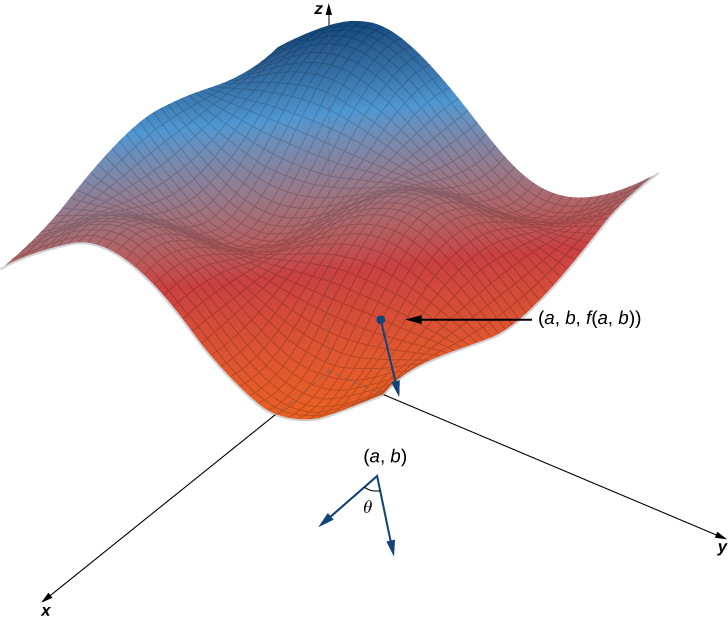
In Partial Derivatives we introduced the partial derivative. A function
has two partial derivatives:
and
These derivatives correspond to each of the independent variables and can be interpreted as instantaneous rates of change (that is, as slopes of a tangent line). For example,
represents the slope of a tangent line passing through a given point on the surface defined by
assuming the tangent line is parallel to the x-axis. Similarly,
represents the slope of the tangent line parallel to the
Now we consider the possibility of a tangent line parallel to neither axis.
We start with the graph of a surface defined by the equation
Given a point
in the domain of
we choose a direction to travel from that point. We measure the direction using an angle
which is measured counterclockwise in the x, y-plane, starting at zero from the positive x-axis ([link]). The distance we travel is
and the direction we travel is given by the unit vector
Therefore, the z-coordinate of the second point on the graph is given by

We can calculate the slope of the secant line by dividing the difference in
by the length of the line segment connecting the two points in the domain. The length of the line segment is
Therefore, the slope of the secant line is
To find the slope of the tangent line in the same direction, we take the limit as
approaches zero.
Suppose
is a function of two variables with a domain of
Let
and define
Then the directional derivative of
in the direction of
is given by
provided the limit exists.
[link] provides a formal definition of the directional derivative that can be used in many cases to calculate a directional derivative.
Let
Find the directional derivative
of
in the direction of
What is
First of all, since
and
is acute, this implies
Using
we first calculate
We substitute this expression into [link]:
To calculate
we substitute
and
into this answer:
(See the following figure.)
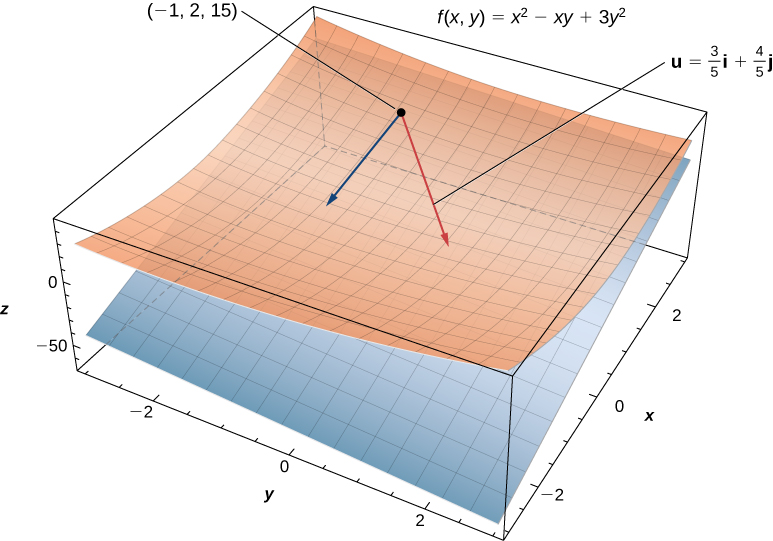
Another approach to calculating a directional derivative involves partial derivatives, as outlined in the following theorem.
Let
be a function of two variables
and assume that
and
exist. Then the directional derivative of
in the direction of
is given by
[link] states that the directional derivative of f in the direction of
is given by
Let
and
and define
Since
and
both exist, we can use the chain rule for functions of two variables to calculate
If
then
and
so
By the definition of
it is also true that
Therefore,
□
Calculate the partial derivatives and determine the value of
If the vector that is given for the direction of the derivative is not a unit vector, then it is only necessary to divide by the norm of the vector. For example, if we wished to find the directional derivative of the function in [link] in the direction of the vector
we would first divide by its magnitude to get
This gives us
Then
The right-hand side of [link] is equal to
which can be written as the dot product of two vectors. Define the first vector as
and the second vector as
Then the right-hand side of the equation can be written as the dot product of these two vectors:
The first vector in [link] has a special name: the gradient of the function
The symbol
is called nabla and the vector
is read
Let
be a function of
such that
and
exist. The vector
is called the gradient of
and is defined as
The vector
is also written as
Find the gradient
of each of the following functions:
The gradient has some important properties. We have already seen one formula that uses the gradient: the formula for the directional derivative. Recall from The Dot Product that if the angle between two vectors
and
is
then
Therefore, if the angle between
and
is
we have
The
disappears because
is a unit vector. Therefore, the directional derivative is equal to the magnitude of the gradient evaluated at
multiplied by
Recall that
ranges from
to
If
then
and
and
both point in the same direction. If
then
and
and
point in opposite directions. In the first case, the value of
is maximized; in the second case, the value of
is minimized. If
then
for any vector
These three cases are outlined in the following theorem.
Suppose the function
is differentiable at
([link]).
then
for any unit vector
then
is maximized when
points in the same direction as
The maximum value of
is
then
is minimized when
points in the opposite direction from
The minimum value of
is
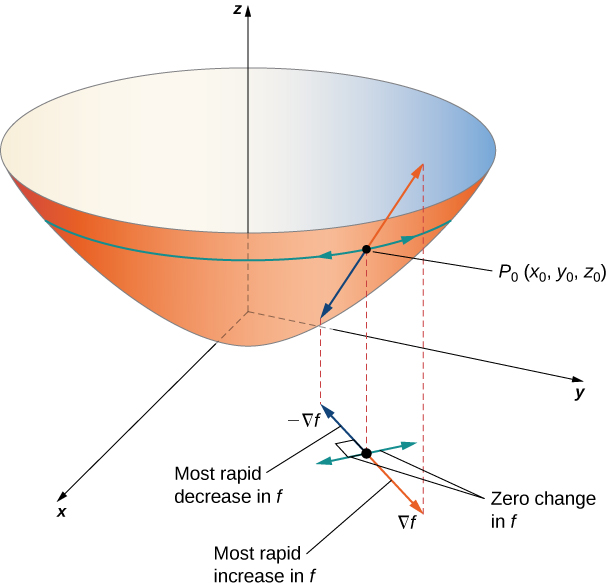
Find the direction for which the directional derivative of
at
is a maximum. What is the maximum value?
The maximum value of the directional derivative occurs when
and the unit vector point in the same direction. Therefore, we start by calculating
Next, we evaluate the gradient at
We need to find a unit vector that points in the same direction as
so the next step is to divide
by its magnitude, which is
Therefore,
This is the unit vector that points in the same direction as
To find the angle corresponding to this unit vector, we solve the equations
for
Since cosine is negative and sine is positive, the angle must be in the second quadrant. Therefore,
The maximum value of the directional derivative at
is
(see the following figure).
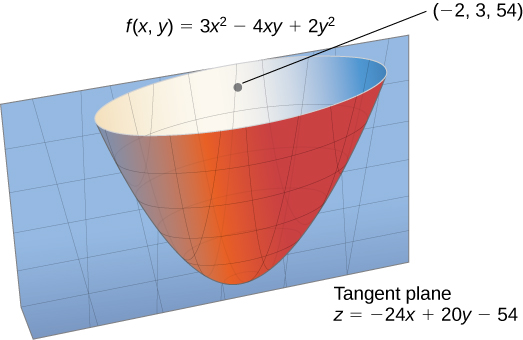
Find the direction for which the directional derivative of
at
is a maximum. What is the maximum value?
The gradient of
at
is
The unit vector that points in the same direction as
is
which gives an angle of
The maximum value of the directional derivative is
Evaluate the gradient of
at point
[link] shows a portion of the graph of the function
Given a point
in the domain of
the maximum value of the gradient at that point is given by
This would equal the rate of greatest ascent if the surface represented a topographical map. If we went in the opposite direction, it would be the rate of greatest descent.
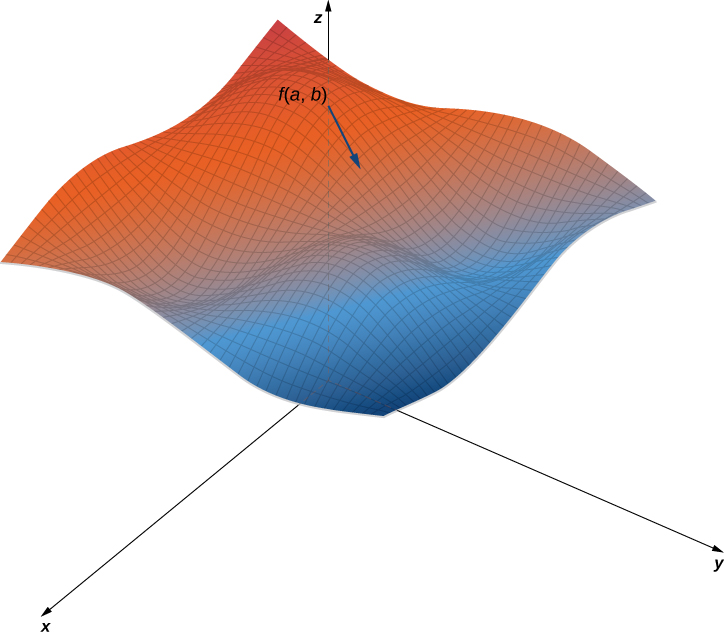
When using a topographical map, the steepest slope is always in the direction where the contour lines are closest together (see [link]). This is analogous to the contour map of a function, assuming the level curves are obtained for equally spaced values throughout the range of that function.
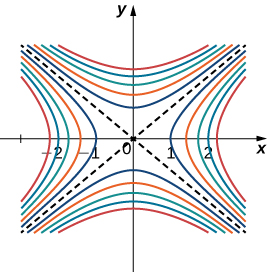
Recall that if a curve is defined parametrically by the function pair
then the vector
is tangent to the curve for every value of
in the domain. Now let’s assume
is a differentiable function of
and
is in its domain. Let’s suppose further that
and
for some value of
and consider the level curve
Define
and calculate
on the level curve. By the chain Rule,
But
because
for all
Therefore, on the one hand,
on the other hand,
Therefore,
Thus, the dot product of these vectors is equal to zero, which implies they are orthogonal. However, the second vector is tangent to the level curve, which implies the gradient must be normal to the level curve, which gives rise to the following theorem.
Suppose the function
has continuous first-order partial derivatives in an open disk centered at a point
If
then
is normal to the level curve of
at
We can use this theorem to find tangent and normal vectors to level curves of a function.
For the function
find a tangent vector to the level curve at point
Graph the level curve corresponding to
and draw in
and a tangent vector.
First, we must calculate
Next, we evaluate
at
This vector is orthogonal to the curve at point
We can obtain a tangent vector by reversing the components and multiplying either one by
Thus, for example,
is a tangent vector (see the following graph).
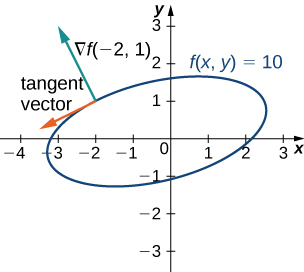
For the function
find the tangent to the level curve at point
Draw the graph of the level curve corresponding to
and draw
and a tangent vector.
Tangent vector:
or
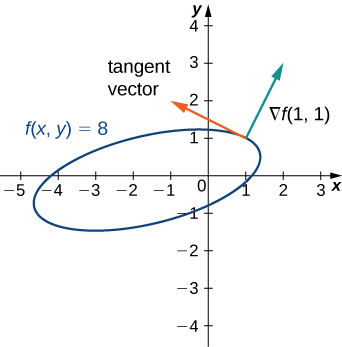
Calculate the gradient at point
The definition of a gradient can be extended to functions of more than two variables.
Let
be a function of three variables such that
exist. The vector
is called the gradient of
and is defined as
can also be written as
Calculating the gradient of a function in three variables is very similar to calculating the gradient of a function in two variables. First, we calculate the partial derivatives
and
and then we use [link].
Find the gradient
of each of the following functions:
Find the gradient
of
The directional derivative can also be generalized to functions of three variables. To determine a direction in three dimensions, a vector with three components is needed. This vector is a unit vector, and the components of the unit vector are called directional cosines. Given a three-dimensional unit vector
in standard form (i.e., the initial point is at the origin), this vector forms three different angles with the positive
and z-axes. Let’s call these angles
and
Then the directional cosines are given by
and
These are the components of the unit vector
since
is a unit vector, it is true that
Suppose
is a function of three variables with a domain of
Let
and let
be a unit vector. Then, the directional derivative of
in the direction of
is given by
provided the limit exists.
We can calculate the directional derivative of a function of three variables by using the gradient, leading to a formula that is analogous to [link].
Let
be a differentiable function of three variables and let
be a unit vector. Then, the directional derivative of
in the direction of
is given by
The three angles
determine the unit vector
In practice, we can use an arbitrary (nonunit) vector, then divide by its magnitude to obtain a unit vector in the desired direction.
Calculate
in the direction of
for the function
First, we find the magnitude of
Therefore,
is a unit vector in the direction of
so
Next, we calculate the partial derivatives of
then substitute them into [link]:
Last, to find
we substitute
Calculate
and
in the direction of
for the function
or
For the following exercises, find the directional derivative using the limit definition only.
at point
in the direction of
at point
in the direction of
Find the directional derivative of
at point
in the direction of
For the following exercises, find the directional derivative of the function at point
in the direction of
For the following exercises, find the directional derivative of the function in the direction of the unit vector
For the following exercises, find the gradient.
Find the gradient of
Then, find the gradient at point
Find the gradient of
at point
Find the gradient of
at
and in the direction of
For the following exercises, find the directional derivative of the function at point
in the direction of
For the following exercises, find the derivative of the function at
in the direction of
[T] Use technology to sketch the level curve of
that passes through
and draw the gradient vector at
[T] Use technology to sketch the level curve of
that passes through
and draw the gradient vector at
For the following exercises, find the gradient vector at the indicated point.
For the following exercises, find the derivative of the function.
at point
in the direction the function increases most rapidly
at point
in the direction the function increases most rapidly
at point
in the direction the function increases most rapidly
at point
in the direction the function increases most rapidly
at point
in the direction the function increases most rapidly
For the following exercises, find the maximum rate of change of
at the given point and the direction in which it occurs.
For the following exercises, find equations of
The level curve
for
at point
at point
a.
b.
at point
at point
a.
b.
For the following exercises, solve the problem.
The temperature
in a metal sphere is inversely proportional to the distance from the center of the sphere (the origin:
The temperature at point
is
in the direction toward point
The electrical potential (voltage) in a certain region of space is given by the function
in the direction of the vector
a.
b.
c.
If the electric potential at a point
in the xy-plane is
then the electric intensity vector at
is
In two dimensions, the motion of an ideal fluid is governed by a velocity potential
The velocity components of the fluid
in the x-direction and
in the y-direction, are given by
Find the velocity components associated with the velocity potential
is defined to be
which can be generalized to a function of any number of independent variables

You can also download for free at http://cnx.org/contents/9a1df55a-b167-4736-b5ad-15d996704270@5.1
Attribution: